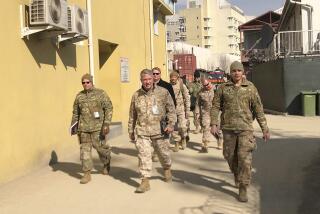U.S. and NATO pledge billions to back Afghan forces

ISLAMABAD, Pakistan — The U.S. and NATO have promised to pay $4 billion a year until 2024 to finance Afghanistan’s military and security forces, which are struggling to contain an advancing Taliban. Already, the U.S. has spent nearly $89 billion over the last 20 years to build, equip and train Afghan forces.
Yet America’s own government watchdog says oversight of the money has been poor, hundreds of millions of dollars have been misspent and corruption is rife in the security apparatus.
Monitoring where the future funding goes will become virtually impossible after Aug. 31, when the last coalition troops leave. Here is a look at some of the issues:
U.S. SPENDING SINCE 2001
Nearly $83 billion has been spent to build, equip, train and sustain Afghanistan’s national security forces, which include the military, national police and elite special forces.
That figure covers a wide range of items. For example, the U.S. spent nearly $10 billion for vehicles and aircraft. It spent $3.75 billion on fuel for the Afghan military from 2010-2020.
Separately, an additional $5.8 billion went into economic and government development and infrastructure since 2001, with the expressed goal of winning public support and blunting the Taliban insurgency. The figures are from reports by John Sopko, the special inspector general on Afghanistan reconstruction, tasked with monitoring how U.S. taxpayer dollars are spent.
The U.S. allocation for 2022 is $3.3 billion. It will include $1 billion to support the Afghan air force and special mission wing, $1 billion for fuel, ammunition and spare parts, and $700 million to pay salaries for Afghan soldiers.
It is difficult to see how the Afghan government will be able to pay to keep its military running after 2024.
More than 80% of the Afghan government budget is paid by the U.S. and its allies, according to the Office of the Special Inspector General for Afghanistan Reconstruction, or SIGAR. Economic projections suggesting Kabul could carry more of the financial burden have been either wrong or vastly exaggerated, Sopko reported. Afghanistan’s growth rate was to be 3.4% in 2021 but instead shrunk by 2%. In the last four of seven years, Afghanistan has missed its economic growth targets.
WASTE AND CORRUPTION
Much of the billions injected into Afghanistan the last two decades has gone largely unmonitored, leading to runaway corruption by both Afghans and foreign contractors.
Sopko has issued dozens of reports identifying waste, mismanagement and outright corruption.
In one instance, the U.S. spent $547 million to buy and refurbish 20 G222 military transport aircraft for the Afghan air force. Sixteen of them were later sold as junk to Afghan scrap dealers for $40,257 because the American refurbishers delivered flawed and unsafe aircraft.
A retired U.S. Air Force general, contrary to retirement rules, had links to the firm that refurbished the planes, according to a report by Sopko this year. The report said the Justice Department informed the watchdog agency in May 2020 that it would not prosecute any criminal or civil cases connected to the G222 program.
Of $7.8 billion provided since 2008 to Afghan civilian authorities for buildings and vehicles, only $1.2 billion went to buildings and vehicles that were used as intended. Only $343.2 million worth of what was acquired was maintained in good condition, Sopko said this year.
The Afghan army and police force officially have about 320,000 members, but SIGAR says the number is closer to 280,000. The discrepancy is attributed to the presence of so-called ghost soldiers, where corrupt officials pad the personnel numbers to collect money, SIGAR reported.
Sopko said in one of his reports that lack of oversight allowed bribery, fraud, extortion and nepotism, “as well as the empowerment of abusive warlords and their militias.”
“Corruption significantly undermined the U.S. mission in Afghanistan by damaging the legitimacy of the Afghan government, strengthening popular support for the insurgency, and channeling material resources to insurgent groups.”
WHAT KIND OF MILITARY IS LEFT?
For all the time, training and money funneled by the U.S. into the Afghan military as a whole, the small, elite commando forces appear to be the only units capable of standing as a bulwark against the Taliban.
As Taliban fighters swept through districts in recent weeks, regular army and police have in many instances either negotiated their surrender to the fighters or simply walked off their bases. Often, their superiors left them without resupplies of ammunition, troops and sometimes even food as they faced the advancing insurgents.
Throughout the war, U.S. air support has been a crucial edge for Afghan forces on the battlefield. So building Afghan capabilities to carry out the role was vital, and the U.S. spent more than $8.5 billion to support and develop the Afghan air force and special mission wing.
However, the Afghan air force risks being largely grounded once the coalition leaves. The Afghans’ fleet of fighter jets is serviced by U.S. contractors, who are leaving along with the troops. Afghan officials say the coalition never gave them the training or infrastructure to carry out maintenance themselves.
The same holds for much of the arsenal of armored vehicles and heavy weapons the Americans have left for the Afghan military.
Several Afghan officials who spoke to the Associated Press were deeply critical of the U.S. and NATO failure to invest in factories to make spare parts, manufacturing plants to produce ammunition and training to produce skilled Afghan mechanics.
“Every bullet had to come from America,” said Gen. Dawlat Waziri, a former Afghan Defense Ministry official. “Why weren’t we making them here?”
Bill Roggio, senior fellow at the Foundation for Defense of Democracies, said the coalition failed the Afghan government and military by making them overdependent on Western support.
More broadly, “the U.S. trained the wrong kind of army — a Western-styled army — when it needed to train an army capable of fighting the Taliban,” said Roggio, who is also senior editor of the Long War Journal.
“The commandos, special forces and air force have performed well, but the regular Afghan army, which make up a bulk of the fighting force, is not up to task,” he said.
MONITORING BILLIONS OF DOLLARS
It’s been several years since U.S. officials have been able to physically monitor U.S.-funded projects, because deteriorating security countrywide drastically restricted U.S. Embassy personnel’s movements.
By 2016, U.S. advisors couldn’t even meet Afghan security officials at their Kabul offices without heavily armored convoys, and later they could only go by helicopter, Sopko’s July report said.
Staff at the U.S. Embassy in Kabul has been reduced to mostly essential personnel since mid-April. An embassy official told the AP that 1,400 Americans remain at the embassy, mostly restricted to the compound.
Roggio said the U.S. and the North Atlantic Treaty Organization had a hard enough time monitoring aid when they were in Afghanistan; it will be virtually impossible once they leave.
“And with the Taliban rampaging across the country,” he added, “the incentive for Afghan officials to plunder the cash only increases.”
More to Read
Sign up for Essential California
The most important California stories and recommendations in your inbox every morning.
You may occasionally receive promotional content from the Los Angeles Times.










